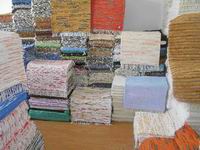Elena Beňušová
One of the most important sources of income for the inhabitants of the upper Orava region (north Slovakia) in the eighteenth and nineteenth centuries was trade with linen and textile. At the beginning of the eighteenth century Orava held second place in Slovakia (after Spiš) in domestic linen production. In numerous Orava municipalities weaving linen was the main source of income for the inhabitants. Orava linen buyers from rich agricultural families bought it and transported it to distant markets in southern Hungary, Rumania, Bulgaria, Turkey, and even sometimes to Egypt, where they sold it at profit. A significant decline can be seen in the first decades of the nineteenth century. However, Orava producers did not give sufficient attention to the quality of linen in the competitive battle, and the decline in Orava linen weaving was also influenced by competition from cotton. The linen weaving craft in Orava has started to experience a renaissance in the last few decades. While in many Orava municipalities weaving lasted only for the needs of the family using the original old loom, this Orava phenomenon found a home in lower Orava with the production of hand-woven carpets. One of the best known locations where nearly every house wove carpets to order for decades for both small and large buyers is the municipality of Malatiná, situated close to the regional town of Dolný Kubín. It is not only women of all ages who weave but also men. This craft has a tradition dating back several hundred years in this municipality. Used clothes that were cut into small pieces were slowly replaced by textile waste, which in the 1980s was ordered and bought from textile factories. The other material weavers still use for hand-woven carpets (not only in Malatiná) is also waste – a cotton material containing hair. It has very good absorption characteristics and is used for wiping hands dirty from oils during works on industrial machines. Initially the colour white prevailed for carpets, and it became fashionable. However, various other colours or their combinations started to be used. Even though the production of hand-woven carpets, as the creators say, is not valued appropriately, it still helps at least partially improve the poor financial situation and lack of jobs in the Orava region. The past is also being repeated again for another point: men are weaving again in Orava.
